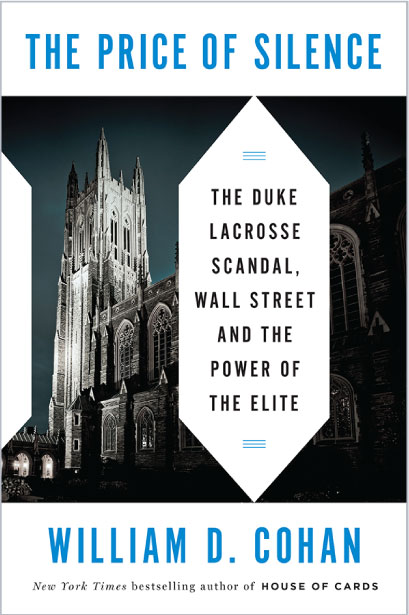The Price of Silence
The Duke Lacrosse Scandal, Wall Street and the Power of The Elite
Despite being front-page news nationwide, the true story of the 2006 Duke lacrosse team rape case has never been told in its entirety and is more complex than all the reportage to date would indicate. The Price of Silence is the definitive, magisterial account of what happens when the most combustible forces in American culture — unbridled ambition, intellectual elitism, athletic prowess, aggressive sexual behavior, racial bias, and absolute prosecutorial authority—collide and then explode on a powerful university campus, in the justice system, and in the media.
What transpired at Duke followed upon the university’s unprecedented and determined effort to compete directly with the Ivy League for the best students and with its Division I rivals for supremacy in selected sports—most famously men’s basketball, where Duke has become a perennial powerhouse and the winner of four national championships. As Cohan brilliantly shows, the pursuit of excellence in such diverse realms put extraordinary strains on the campus culture and—warned some longtime Duke observers—warped the university’s academic ethos. Duke became known for its “work hard, play hard” dynamic, and specifically for its wild off-campus parties, where it seemed almost anything could happen—and often did. Cohan’s reconstruction of the scandal’s events—the night in question, the local police investigation, Duke’s actions, the lacrosse players’ defense tactics, the furious campus politics—is meticulous and complete. Readers who think they know the story are in for more than one surprise, for at the heart of it are individuals whose lives were changed forever.
ACCODLADES
praise
“William Cohan’s fascinating The Price of Silence shows that the Duke lacrosse case was not just a controversial legal investigation that became a heated media circus but also a conflict that illuminated the fierce pressures on America’s elite universities as they battle for power and prestige and money. Cohan’s deep character study of the principal figures involved also reveals the case as a crucible of fate that created distinct winners and losers.”
—Bryan Burrough, Vanity Fair special correspondent, author of Public Enemies and The Big Rich and co-author of Barbarians at the Gate
“William Cohan’s scrupulously reported and grippingly written account of this elite campus horror story makes clear that if you thought you knew what happened at Duke, as I did, there is much more to learn. This is a story that ought to disturb anyone who cares about contemporary college life. For the first time, Cohan gets many of the central characters to speak—and what they haveto say is eye-opening.”
—Jane Mayer, Staff Writer at the New Yorker, author of The Dark Side, and co-author of Strange Justice and Landslide
reviews
“Top-notch investigative journalism defines this examination of “one of the most improbable legal sagas in American history,” by journalist Cohan (Money and Power). According to Cohan, the 2006 indictment of three of the university’s lacrosse players on charges of sexual assault “served as a lightning rod… for complex issues of race, sex, violence, privilege and elitism that had been simmering at Duke for decades.” Cohan’s meticulous account utilizes commentary, court records, and interviews to tell a story of “legal hijinks and media histrionics” and their devastating results. With chilling clarity, Cohan traces how public opinion, initially buoyed by negative media reports, first accused the players of maintaining a “wall of silence” and then turned against the alleged victim and the zealous Durham district attorney. Cohan perceptively plumbs the festering tensions of “racism, sexism, misogyny, alcohol culture, paternalism, economic exploitation, athlete impunity” and perceptions of Duke’s “entitlement and privilege.” What emerges is not just an edge-of-your-seat courtroom drama and a cautionary tale, but also an illuminating fable about the power of status, talent, authority, and belief. Throughout, Cohan’s spare prose and objective tone cast his subjects in a humane light, even when their behavior is stunning. This weighty tome will no doubt prove the definitive account of the case.”
—Publisher’s Weekly, (starred review)
“Vanity Fair contributing editor and Duke University alumnus Cohan (Money and Power: How Goldman Sachs Came to Rule the World, 2011) turns a microscopic lens on the 2006 scandal involving an alleged rape by members of the school’s lacrosse team. The case of a group of white athletes at an elite Southern university accused of raping an African-American stripper exploded into national headlines in the spring of 2006 and continued to play out in the media over the following year. A confluence of perennial hot-button issues related to race, class, money, athletics, politics and power made the Duke lacrosse scandal perfect fodder for the traditional media and its growing online counterpart. Initial condemnation of the accused, whose team’s arrogant and often drunken behavior in the preceding years had drawn the ire of locals, professors and fellow students, eventually gave way to rising questions about the handling of the case by the Duke administration, the media and, most crucially, by the police and prosecution, led by Durham, N.C., District Attorney Mike Nifong. Cohan seemingly leaves no stone unturned in covering all aspects of the case: the criminal proceedings, the media coverage and its impact, and the issues raised in the community and at Duke and other similar schools. The author mostly refrains from editorializing, letting the voluminous evidence and historical record speak for itself, carried along by the story’s undeniably gripping drama. That he does have an opinion on the matter comes through, however, particularly in his descriptions of those involved. Nifong, whose epic mishandling of the case cost him his career and impacted the lives of all participants, remains unwilling, or unable, to comprehend his failures. Cohan’s book will hopefully help others avoid them. A comprehensive, illuminating and highly readable study of a notorious episode in the annals of the American justice.
—Kirkus Review

